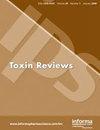氯氰菊酯对家兔呼吸毒性的剂量依赖性谱
IF 2.4
4区 医学
Q2 TOXICOLOGY
引用次数: 1
摘要
拟除虫菊酯是常用的杀虫剂。呼吸短促和呼吸困难是暴露的主要迹象;然而,它们对呼吸系统的影响很少被研究。本研究探讨了氯氰菊酯(CY)对家兔呼吸系统的影响。不同剂量和时间的CY的作用是本研究的新奇之处。剂量(50,100和150mg)。随机分为4组,连续9周,每周腹腔注射CY (kg-1体重)。数据分析显示呼吸体征不同,纤维蛋白原显著(p≤0.05)降低,中性粒细胞-淋巴细胞(NL)、ldl -淋巴细胞(LL)、De-Ritis比值(DR)升高,肺部病变明显(p≤0.05)。这些效应的发生频率和发生率是剂量依赖性的。CY会导致肺部症状和过敏反应。肺损伤使血浆中游离血红素增加,引起肺水肿伴溶血。肺气肿和纤维化随嗜碱性细胞和单核细胞向肺的迁移而发生。本研究推断CY暴露导致纤维蛋白原降低,NL、LL和DR比值升高,肺部病变,预示免疫力低下,尤其是心肺疾病的风险增加。本文章由计算机程序翻译,如有差异,请以英文原文为准。
Dose- and dosage-dependent spectrum of respiratory toxicity of cypermethrin in rabbits
Abstract Pyrethroids are popular insecticides. Shortness of breath and dyspnea are key signs of exposure; however, their respiratory effects are rarely studied. This study investigated the combination and ratios of specific blood tests and lung lesions as respiratory effects of cypermethrin (CY) in rabbits. The effects of CY at various doses and times are the novelty of this study. Doses (50, 100, and 150 mg.kg-1 body weight) of CY were injected intraperitoneally every week for up to 9 weeks in rabbits assigned into four equal groups. Data analysis revealed various respiratory signs, significantly (p ≤ 0.05) lower fibrinogen, higher neutrophils-lymphocytes (NL), LDH-lymphocytes (LL), and De-Ritis ratios (DR), and lesions in the lungs. The frequency and incidence of these effects were dose and dosage dependent. The CY leads to pulmonary signs and allergic effects. Lung injury increases cell-free heme in plasma, causing pulmonary edema with hemolysis. Emphysema and fibrosis followed the migration of basophils and mononuclear cells to the lungs. This study inferred that CY exposure caused lower fibrinogen, higher NL, LL, and DR ratios, and pulmonary lesions, which forecast poor immunity, especially increased risk for cardiac and lung diseases.
求助全文
通过发布文献求助,成功后即可免费获取论文全文。
去求助
来源期刊

Toxin Reviews
医学-毒理学
CiteScore
6.80
自引率
0.00%
发文量
36
审稿时长
>12 weeks
期刊介绍:
Toxin Reviews provides an international forum for publishing state-of-the-art reviews and guest-edited single topic special issues covering the multidisciplinary research in the area of toxins derived from animals, plants and microorganisms. Our aim is to publish reviews that are of broad interest and importance to the toxinology as well as other life science communities. Toxin Reviews aims to encourage scientists to highlight the contribution of toxins as research tools in deciphering molecular and cellular mechanisms, and as prototypes of therapeutic agents. Reviews should emphasize the role of toxins in enhancing our fundamental understanding of life sciences, protein chemistry, structural biology, pharmacology, clinical toxinology and evolution. Prominence will be given to reviews that propose new ideas or approaches and further the knowledge of toxinology.
 求助内容:
求助内容: 应助结果提醒方式:
应助结果提醒方式:


